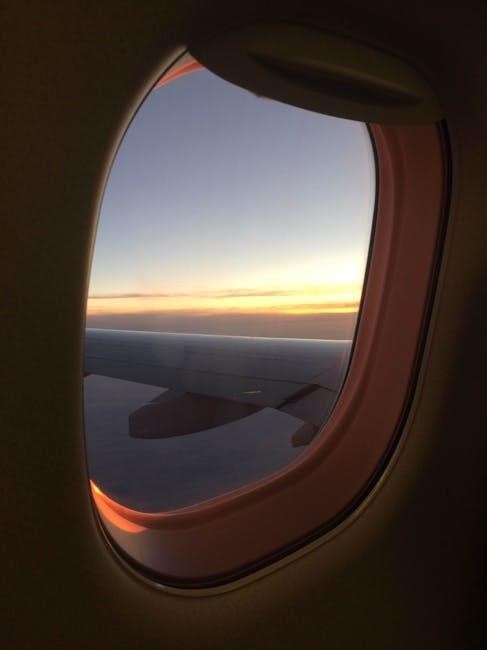Welcome to the fascinating world of aircraft, where innovation meets exploration. From commercial jets to military planes, aviation shapes global connectivity and defense, blending history with cutting-edge technology.
Overview of the Importance of Aircraft
Aircraft are vital to global connectivity, enabling rapid transportation of people and goods. They drive economic growth, facilitate international trade, and support military defense. Commercial aviation links cities worldwide, while private planes offer personalized travel. Advances in fuel efficiency and technology enhance performance, reducing environmental impact. Aircraft also play a critical role in emergencies, such as medical evacuations and disaster relief. Their versatility and innovation underscore their importance in shaping modern society and addressing global challenges effectively.
Historical Development of Aviation
Aviation has evolved significantly since the Wright brothers’ first flight in 1903. Early aircraft were simple, with wooden frames and fabric coverings. World War I accelerated innovation, introducing metal planes and more powerful engines. The 1920s-1930s saw the rise of commercial aviation with Boeing 314 and DC-3, revolutionizing global travel. Post-WWII, jet engines transformed flight speed and efficiency, leading to iconic aircraft like the Boeing 707. Modern advancements include fly-by-wire systems, composite materials, and fuel-efficient designs, continuously shaping the future of aviation and its impact on society.
Key Innovations in Aircraft Design
Advancements in aerodynamics, materials, and propulsion have revolutionized aircraft design. Lightweight composites and advanced alloys reduce weight while enhancing strength. Improved engine efficiency, such as high-bypass turbofans, lowers fuel consumption and emissions. Wing designs, including raked wingtips, optimize lift and reduce drag. Avionics integration streamlines cockpits, improving safety and pilot workload. Quiet engine technology minimizes noise pollution. These innovations enable aircraft to fly farther, carry more passengers, and operate more sustainably, shaping the future of aviation and meeting growing global demands for efficient air travel.

Commercial Aircraft
Commercial aircraft are the backbone of global air travel, connecting millions daily. They range from narrow-body jets like the Airbus A320 to wide-body planes like the Boeing 777, ensuring efficient and comfortable transportation worldwide.
Narrow-Body Aircraft (e.g., Airbus A320, Boeing 737)
Narrow-body aircraft, such as the Airbus A320 and Boeing 737, are the most common in commercial aviation. These jets are designed for short to medium-haul flights, offering efficiency and comfort. The A320, with its advanced fly-by-wire system, and the 737, known for its reliability, dominate the skies. They typically accommodate 150-200 passengers, making them ideal for high-demand routes. Their fuel efficiency and versatility have made them favorites among airlines, ensuring they remain central to global air travel.
Wide-Body Aircraft (e.g., Airbus A350, Boeing 777)
Wide-body aircraft like the Airbus A350 and Boeing 777 are designed for long-haul, international routes, offering unparalleled comfort and capacity. These jets feature twin aisles and larger cabins, accommodating up to 400 passengers. The A350 incorporates advanced materials and fuel-efficient engines, while the 777 is renowned for its reliability and range. Both models have revolutionized long-distance travel, combining efficiency with passenger comfort. Their advanced technology and spacious interiors make them indispensable for global connectivity and premium airline services.
Regional Jets and Turboprops
Regional jets and turboprops are essential for short to medium-haul flights, connecting smaller airports and remote areas. Aircraft like the Embraer E-Jet and Bombardier CRJ are popular, offering efficiency and comfort for up to 100 passengers. Turboprops, such as the ATR 72, excel in fuel efficiency and versatility, often serving regional routes. These aircraft are crucial for airlines, providing cost-effective solutions for smaller markets while maintaining high performance and reliability. They play a vital role in sustaining commercial aviation’s accessibility and connectivity worldwide.
Economic Impact of Commercial Aviation
Commercial aviation is a cornerstone of global economic growth, generating millions of jobs and facilitating international trade. Airlines transport billions of passengers and tons of cargo annually, driving tourism, business, and cultural exchange. The industry’s economic ripple effect extends to airports, hospitality, and related sectors. Fuel efficiency advancements, like those in the A320 and 737-400 comparisons, highlight cost reductions and environmental efforts, further sustaining aviation’s pivotal role in the global economy while addressing sustainability challenges for future operations.
Military Aircraft
Military aircraft are vital for national defense, surveillance, and combat operations. They include fighter jets, bombers, and transport planes, each designed for specific strategic and tactical missions globally.
Fighter Jets (e.g;, F-35, Su-57)
Fighter jets are advanced military aircraft designed for air superiority and multirole missions. The F-35 Lightning II, a fifth-generation stealth fighter, excels in precision strikes and versatility. Meanwhile, the Su-57 Felon, Russia’s cutting-edge stealth fighter, features advanced avionics and supersonic capabilities. Both aircraft represent the pinnacle of modern aerospace engineering, combining stealth technology, maneuverability, and network-centric warfare capabilities. These jets are crucial for modern air forces, ensuring dominance in contested skies and adapting to evolving threats in the 21st century.
Bomber Aircraft (e.g., B-2, Tu-160)
Bomber aircraft are strategic weapons systems designed for delivering massive payloads over long distances. The B-2 Spirit, a stealth bomber, features a flying wing design for radar evasion, carrying nuclear and conventional weapons. The Tu-160, a Russian supersonic bomber, boasts unmatched speed and range, capable of launching cruise missiles. Both aircraft are pivotal in global strategic deterrence, combining advanced technology with raw firepower to project military power across vast territories, ensuring their role as critical assets in modern air forces.
Transport and Tanker Aircraft (e.g., C-17, Il-76)
Transport and tanker aircraft are essential for military logistics and humanitarian missions. The C-17 Globemaster III excels in strategic airlift, capable of carrying heavy loads to remote areas. The Il-76, a Soviet-era workhorse, remains a versatile freighter and firefighter. Both aircraft feature robust designs, enabling them to operate in challenging environments. Their ability to refuel in flight or deliver supplies makes them indispensable for global operations, ensuring sustained military presence and disaster relief capabilities, highlighting their critical role in modern airpower and crisis response scenarios worldwide.
Unmanned Aerial Vehicles (UAVs)
Unmanned Aerial Vehicles (UAVs), or drones, are remotely controlled or autonomous aircraft used for surveillance, combat, and civilian purposes. Military UAVs like the MQ-9 Reaper and MQ-20 Avenger perform reconnaissance and precision strikes. Civilian applications include aerial photography, agriculture, and package delivery. Equipped with advanced sensors and navigation systems, UAVs reduce human risk in dangerous missions. Their versatility, coupled with evolving AI and autonomous technologies, makes them pivotal in modern aviation, offering cost-effective solutions for diverse industries while addressing challenges like cybersecurity and regulatory frameworks.
General Aviation
General aviation encompasses private and non-commercial aircraft, including single-engine planes, helicopters, and gliders. It supports personal flying, training, and specialized operations, fostering a vibrant aviation culture worldwide.
Private Single-Engine Aircraft (e.g., Cessna 172)
Private single-engine aircraft, like the iconic Cessna 172, are popular for personal flying and flight training. Known for their simplicity, reliability, and affordability, these planes are ideal for small groups. They typically feature a four-seat capacity, making them versatile for both recreation and education. The Cessna 172, with its durable design and forgiving handling, has become a cornerstone in aviation training worldwide. Its widespread use underscores its importance in general aviation, offering a practical gateway to the skies for many pilots.
Multi-Engine and Business Aircraft (e.g., Beechcraft, Gulfstream)
Multi-engine and business aircraft, such as Beechcraft and Gulfstream, offer enhanced performance, comfort, and versatility. These planes are designed for corporate travel and private use, combining luxury with efficiency. Twin engines provide redundancy and improved safety, while advanced avionics ensure smooth operations. Gulfstream jets, known for their speed and range, cater to executives needing global accessibility. Beechcraft models, like the King Air, excel in versatility, offering both passenger and cargo capabilities. These aircraft represent the pinnacle of private aviation, blending power, technology, and elegance for discerning travelers and businesses.
Helicopters (e.g., Robinson R22, Bell 407)
Helicopters like the Robinson R22 and Bell 407 are versatile machines, excelling in various roles such as training, medical transport, and commercial operations. The Robinson R22 is a popular choice for flight schools due to its affordability and ease of handling. The Bell 407, with its larger capacity and smooth ride, is ideal for emergency medical services and corporate transport. Both models highlight the unique capabilities of helicopters, offering maneuverability and flexibility in diverse operational environments, making them indispensable in modern aviation.
Gliders and Light Sport Aircraft
Gliders and light sport aircraft offer a unique flying experience, emphasizing simplicity and accessibility. Gliders, like the Schweizer 2-33, rely on gravity and air currents for flight, providing serene and fuel-free aviation. Light sport aircraft, such as the Cirrus SR20, are designed for recreational flying, with lower costs and easier licensing requirements. These aircraft are popular for training, sightseeing, and personal enjoyment; Their lightweight designs and efficient performance make them ideal for smaller airfields and hobbyist pilots, fostering a sense of freedom and connection to the fundamentals of flight.
Aircraft Manufacturers
Leading global aircraft manufacturers include Boeing, Airbus, and Lockheed Martin, driving innovation and producing iconic models that shape the aviation industry.
Boeing
Boeing is a global leader in aircraft manufacturing, renowned for its innovative designs and iconic models. Founded in 1916, the company has produced legendary planes like the 747 and 787 Dreamliner. Known for its commitment to safety and efficiency, Boeing continues to push aviation boundaries, serving both commercial and military sectors. Its aircraft are integral to air travel worldwide, setting standards for reliability and performance. Boeing’s legacy is built on pioneering technology and a vision for the future of flight.
Airbus
Airbus is a European aerospace giant, competing with Boeing as a leading aircraft manufacturer. Established in 1970, Airbus revolutionized aviation with the A320 family and A350 XWB. Known for its focus on innovation, Airbus emphasizes fuel efficiency and passenger comfort. The A380, the world’s largest passenger jet, exemplifies its ambitious projects. Airbus continues to advance aviation technology, shaping the future of air travel with sustainable and advanced aircraft designs. Its global influence underscores its role in modern aviation.
Lockheed Martin
Lockheed Martin is a global leader in aerospace and defense, renowned for producing iconic military aircraft. Notable designs include the F-35 Lightning II, the world’s most advanced fighter jet, and the U-2 spy plane. Lockheed Martin has also contributed to historic projects like the SR-71 Blackbird. The company’s innovations extend to helicopters and missile systems, solidifying its role in modern defense. With a focus on cutting-edge technology, Lockheed Martin continues to shape global airpower and security through its advanced aircraft designs and systems.
Other Notable Manufacturers (e.g., Bombardier, Embraer)
Bombardier and Embraer are key players in the aviation industry, specializing in regional and business aircraft. Bombardier’s Global and Challenger series are renowned for luxury and range, while Embraer’s Phenom and Legacy jets offer versatility. Both manufacturers have also made significant contributions to regional aviation, with Embraer’s E-Jets and Bombardier’s CRJ series being widely used. Their commitment to innovation and performance ensures they remain competitive in the global market, providing efficient and reliable aircraft solutions for various aviation needs.

Aircraft Design and Technology
Aircraft design integrates aerodynamics, propulsion, and materials science to optimize performance, efficiency, and safety, driving advancements in aviation technology for both commercial and military applications globally.
Aerodynamics and Performance
Aerodynamics is crucial for aircraft performance, focusing on reducing drag and enhancing lift. Advanced wing designs, such as raked wingtips, improve fuel efficiency. Airflow simulation tools optimize shapes for minimal resistance. Engine placement and nose cone design also impact aerodynamic efficiency. These innovations ensure planes fly farther, faster, and with less fuel, making modern aviation more sustainable and cost-effective. Continuous research in aerodynamics drives progress, enabling aircraft to meet growing demands for speed, range, and environmental performance.
Propulsion Systems (Jets, Turboprops, Pistons)
Propulsion systems are the heart of aircraft, determining speed, range, and efficiency. Jet engines, used in commercial and military planes, offer high thrust for long-distance flights. Turboprops, common in regional aircraft, provide excellent fuel economy for shorter routes. Piston engines, found in smaller planes, are simple and cost-effective for private use. Advances in materials and design have improved fuel efficiency and reduced emissions, making modern propulsion systems more capable and environmentally friendly. Each type is tailored to specific aviation needs, ensuring optimal performance across various applications.
Avionics and Navigation Systems
Avionics and navigation systems are critical for safe and efficient flight operations. Modern aircraft rely on advanced GPS, ADS-B, and flight management systems (FMS) for precise navigation. These technologies enhance situational awareness, reduce pilot workload, and improve communication with air traffic control. Additionally, tools like Envision and contour plotting assist in data visualization and analysis. Avionics systems also integrate weather radar, autopilot, and collision avoidance systems, ensuring safer skies. Advances in avionics have revolutionized aviation, enabling more accurate flight planning and real-time decision-making, while reducing operational risks and improving overall efficiency.
Advanced Materials and Construction
Modern aircraft construction relies on cutting-edge materials like carbon fiber composites, titanium alloys, and advanced aluminum-lithium alloys. These materials offer exceptional strength-to-weight ratios, enabling lighter, more fuel-efficient designs. Composite materials reduce corrosion and increase durability, while titanium provides high strength in extreme temperatures. Innovations in manufacturing, such as 3D printing, allow for complex components with reduced material waste. These advancements contribute to improved aircraft performance, fuel efficiency, and environmental sustainability, shaping the future of aviation with stronger, lighter, and more resilient structures.

Modern Trends in Aviation
Aviation is evolving rapidly with electric propulsion, AI integration, and urban air mobility, setting the stage for a greener, smarter, and more connected future in flight.
Fuel Efficiency and Environmental Impact
Improving fuel efficiency is a top priority in aviation, driven by rising fuel costs and environmental concerns. Modern aircraft like the Airbus A350 and Boeing 787 use advanced engine technologies and lightweight materials to reduce fuel consumption. Sustainable Aviation Fuels (SAF) are also gaining traction, offering a cleaner alternative to traditional jet fuel. These innovations aim to minimize carbon emissions and address climate change. The industry is committed to achieving net-zero emissions by 2050, making eco-friendly practices central to future aviation strategies.
Electric and Hybrid-Electric Propulsion
Electric and hybrid-electric propulsion systems are revolutionizing aviation by reducing emissions and operating costs. These systems replace traditional fossil-fuel engines with electric motors powered by batteries or hybrid systems. Examples include Eviation’s Alice, an all-electric commuter aircraft, and NASA’s X-57 Maxwell, a hybrid-electric test plane. While battery technology limits range and payload, advancements in energy density and efficiency are driving progress. These innovations promise quieter, cleaner, and more sustainable flight options, particularly for short-haul and urban air mobility applications.
Artificial Intelligence in Aviation
Artificial intelligence (AI) is transforming aviation by enhancing safety, efficiency, and decision-making. AI algorithms analyze vast data sets to optimize flight paths, predict weather patterns, and detect potential mechanical issues. Machine learning systems improve predictive maintenance, reducing downtime and costs. AI also enhances air traffic control, streamlining operations and reducing delays. Additionally, autonomous systems are being developed for unmanned aerial vehicles (UAVs) and self-piloted aircraft. These advancements promise to revolutionize the industry, making air travel safer, greener, and more accessible while addressing future challenges in aviation.
Urban Air Mobility (UAM)
Urban Air Mobility (UAM) represents the future of transportation, aiming to alleviate traffic congestion in cities. Electric and hybrid-electric vertical takeoff and landing (eVTOL) aircraft, such as drones and air taxis, are central to this concept. These vehicles enable on-demand air transport within urban areas, reducing travel time and emissions. Autonomous systems and advanced navigation technologies are being developed to ensure safety and efficiency. UAM also addresses infrastructure challenges by utilizing existing vertiports and landing pads. This innovation promises to transform urban transportation, offering sustainable and accessible mobility solutions for the future.

Specialized Aircraft
Specialized aircraft are designed for unique missions, including supersonic flight, amphibious operations, and cargo transport. These planes excel in specific environments and tasks, driving innovation and efficiency.
Supersonic Aircraft (e.g., Concorde, X-59 QueSST)
Supersonic aircraft, like the iconic Concorde and NASA’s X-59 QueSST, are engineered to surpass the speed of sound. Concorde, retired in 2003, offered luxury transatlantic flights at Mach 2.0. The X-59 QueSST aims to reduce sonic booms, enabling supersonic flight over land. These aircraft showcase cutting-edge technology, overcoming challenges like noise and fuel efficiency. Their development pushes aviation boundaries, promising future advancements in speed and performance for both military and civilian applications.
Amphibious and Seaplanes (e.g., Canadair CL-415)
Amphibious and seaplanes are versatile aircraft capable of operating on both water and land. The Canadair CL-415, a renowned amphibious aircraft, excels in firefighting, featuring a water-scooping system and robust design. Historically, seaplanes like the Martin PBY Catalina have played crucial roles in maritime patrols and rescues. Modern designs, such as the Beriev A-40 Albatross, highlight advanced capabilities, including beach landings and anti-submarine missions. These aircraft are indispensable in coastal and remote regions, offering unique operational flexibility and specialized functionalities.
Cargo and Freight Aircraft (e.g., Antonov An-124)
Cargo and freight aircraft are specialized for transporting large volumes of goods, crucial for global logistics. The Antonov An-124, one of the largest cargo planes, can carry up to 150 tons, making it indispensable for heavy-duty shipments. Designed for oversized loads, it features a massive cargo bay and robust landing gear. Other notable freighters include the Boeing 747F and Airbus A350F, offering high efficiency and capacity. These aircraft are vital for industries requiring rapid, reliable transportation of goods worldwide, ensuring supply chains remain uninterrupted and efficient.
Experimental and Concept Aircraft
Experimental and concept aircraft push the boundaries of aviation innovation, showcasing futuristic designs and technologies. These aircraft are often prototypes or testbeds for new ideas, such as hypersonic flight or electric propulsion. Examples include the X-59 QueSST, designed to reduce sonic booms, and hybrid-electric prototypes aiming to lower emissions. These planes are not yet in mass production but demonstrate what the future of aviation could hold. They allow manufacturers to test radical designs, materials, and systems, paving the way for breakthroughs in performance, efficiency, and sustainability.
The Future of Aviation
The future of aviation is defined by innovation, sustainability, and technological advancements. Electric propulsion, hypersonic travel, and autonomous systems are reshaping the industry, promising faster, cleaner, and smarter flight.
Spaceplanes and Hypersonic Aircraft
Spaceplanes and hypersonic aircraft represent the next frontier in aviation, combining space exploration with ultra-high-speed flight. These vehicles operate at the edge of space and beyond, enabling rapid global travel and access to low Earth orbit. Hypersonic aircraft, capable of speeds over Mach 5, promise revolutionary transportation solutions. Meanwhile, spaceplanes like reusable launch vehicles are transforming space access, reducing costs, and enabling frequent missions. Both technologies face challenges in materials, propulsion, and funding but hold immense potential for military, scientific, and commercial applications, reshaping the future of aerospace exploration and connectivity.
Sustainable Aviation Fuels (SAF)
Sustainable Aviation Fuels (SAF) are a cleaner alternative to traditional jet fuel, made from renewable sources like waste materials and plants. They significantly reduce greenhouse gas emissions, with potential lifecycle reductions of up to 80%. SAF is a critical component of aviation’s net-zero emissions target by 2050. Despite higher costs, growing investments and partnerships are driving its adoption. Compatible with existing engines and infrastructure, SAF is a key step toward decarbonizing air travel and achieving a more sustainable aviation future while addressing climate change challenges.
Next-Generation Air Traffic Management
Next-generation air traffic management leverages advanced technologies like AI, machine learning, and big data to optimize flight paths and reduce delays. Real-time data analytics enable precise decision-making, enhancing safety and efficiency. Automated systems streamline communication between controllers, airlines, and airports, improving traffic flow. This modern approach reduces fuel consumption and emissions, supporting environmental goals. By integrating cutting-edge tools, next-gen ATM systems are transforming aviation operations, ensuring smoother and more sustainable air travel experiences globally while addressing future airspace demands and challenges effectively.
Autonomous and Self-Piloted Aircraft
Autonomous and self-piloted aircraft represent the future of aviation, utilizing advanced AI, machine learning, and sensor technologies to operate without human intervention. These systems enable precise navigation, real-time decision-making, and enhanced safety by minimizing human error. Autonomous aircraft can optimize flight paths, reduce fuel consumption, and improve efficiency. Applications range from cargo transport to surveillance, with potential for passenger flights. The aviation industry is actively developing these technologies, with ongoing research and regulatory efforts to ensure safety and reliability, paving the way for a new era of intelligent and efficient air travel solutions worldwide.